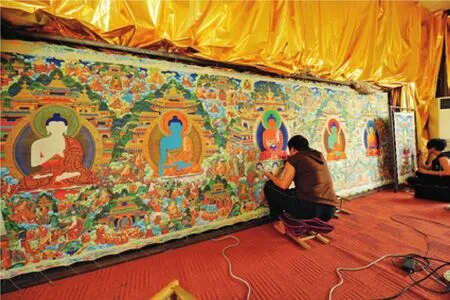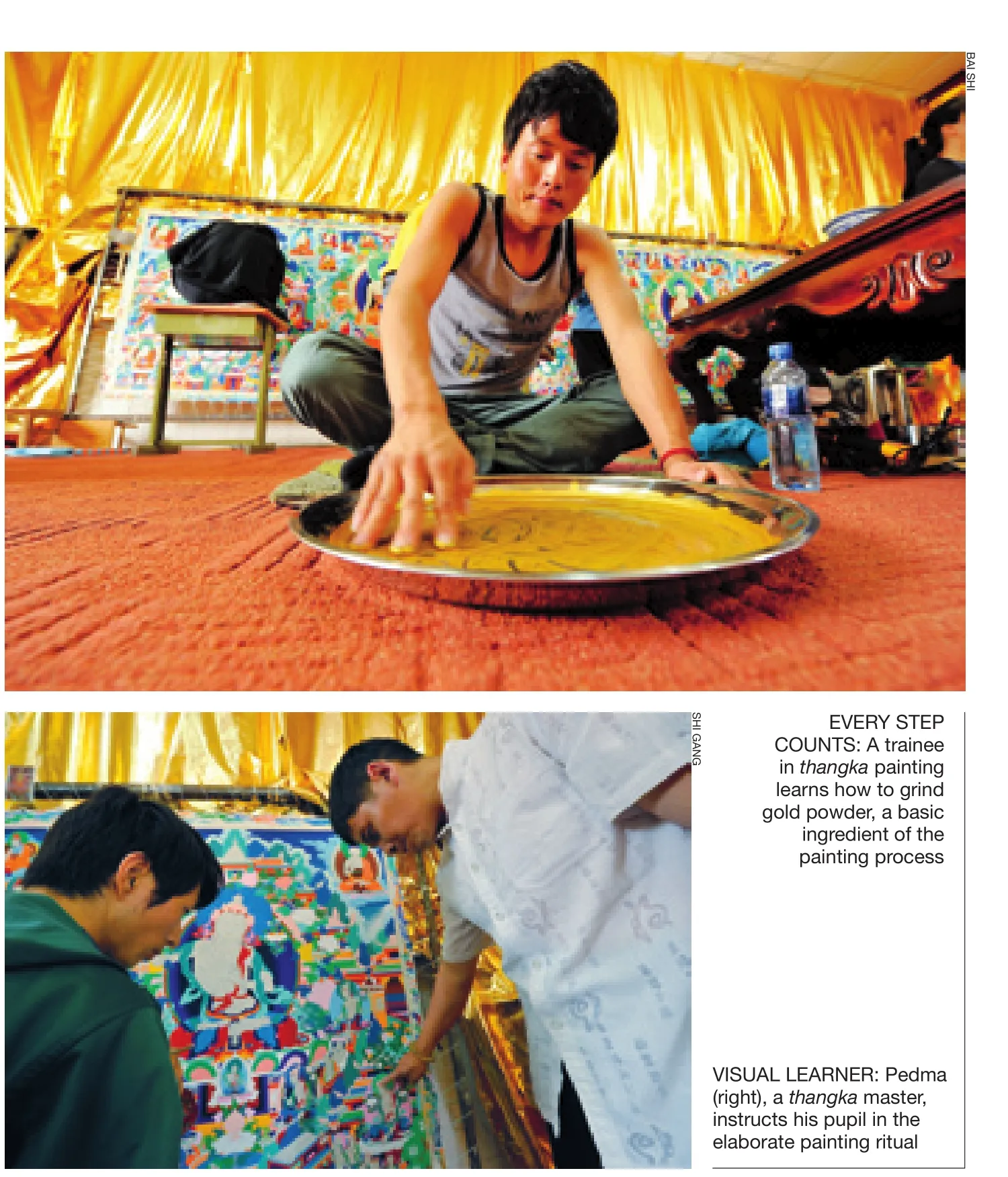Keeping Buddha in Mind
2012-10-14charityfoundationtrainsstudentstolearntheTibetanartofthangkapaintingByXuBei
A charity foundation trains students to learn the Tibetan art of thangka painting By Xu Bei
Keeping Buddha in Mind
A charity foundation trains students to learn the Tibetan art of thangka painting By Xu Bei

TWO-YEaR DEVOTiON: a thangka master from Qinghai Province spends two years painting this 5-meter-long and 1.3-meter-wide thangka
The 20-square-meter classroom is bedecked with golden cloth and the atmosphere is thick with the strong smell of animal glue. A shrine to Buddha sits at the entrance of the classroom and religious music softly plays in the background. Teacher Pedma painted Tibetanthangkaembroidered scrolls with his students inside a courtyard in Beijing’s Huairou District on June 1.
Students concentrated on drawing pictures, some in groups and some individually, coloring the paintings, drawing with slender calligraphy brushes, and tracing copies ofthangkawith a pencil.
“Such decoration in the classroom is to create a monastic atmosphere,” said He Bin, deputy head of the Tibetan Cultural Charity Foundation. “Thangkapainting is inseparable from devout faith in the Buddha, which is a charm of the art form.”
The foundation has operated two terms of classes to enable students to inherit the art, enrolling 48 students from poverty-stricken families in west China’s Sichuan and Qinghai provinces, both of which are home to large Tibetan communities.
Thangkais a method of painting featuring religion, history, politics, culture and social activities and is essential to understanding Tibet and its culture.
Since the period of Tubo King Songtsan Gampo in the seventh century,thangkahas survived for over 1,300 years.
Originally,thangkawas painted with mineral pigments over embroidered tapestry and served as a portable shrine for Buddhist icons, as it was difficult for typically nomadic Tibetans to carry with bulky bronze sculptures or woodcarvings of Buddha statues for worship. Thus,thangkais also known as a“walking Buddha niche.”
In 2006, the Tibetan art ofthangkawas listed among the first batch of national intangible cultural heritage items, drawing attention to its preservation and inheritance.
Learning the art
Two students had been grinding gold powder and foil into lacquer for two days. Painters will use a calligraphy brush to decorate the golden highlights of the Buddha image, and then polish it with a metal pencil to prevent fading.
Grinding is not an easy task, and Pedma refuses visitors on the first day of the process.“It is a custom,” he said.
After drawing Buddha’s body, clothes, offerings and background scenery, the most difficult technique is to draw the face, as the minute details such as the angles of the eyes, ears, nose and lips are critically important for judging the full expression of Buddhist epistemological concepts.
Despite having colored many paintings, 22-year-old Cédain has never drawn facial features. He is from Longwuzhen Village in Tongren County in northwest China’s Qinghai Province, and has studiedthangkafor seven years.
“I began to learn the art of drawingthangkawhen I was in Qinghai, and continued learning in Beijing for another two years,” he toldBeijing Review. “The foundation offered to cover the costs of traveling home twice a year during the summer vacation and Tibetan New Year,” he said. He added that his reason for leaving home for faraway Beijing was to learn artistic techniques, study Buddhist principles and paintthangka.
“Failing to draw [the facial features] will spoil a whole painting, so my great expectation is to do the last step of the painting and become a full-fledgedthangkapainter just like my teacher,” said Cédain.
Required course
Asthangkapainting requires delicate technique, collection ofthangkapaintings has been in vogue in recent years.
However, it is the piety of the painters that endowsthangkawith its unique charms, according to Pedma. “Without piety, even with exquisite skill, the painting would lose its sense and cultural foundation.”
“It will take 10 years to cultivate athangkapainter,” Pedma continued. “However, some painters begin to work independently after only two years’ learning, and each of their paintings would be sold at a price of 2,000 yuan ($316),” he said.
Such quick learning resulted in a lack of creativity. Without piety and solid skills, such works have no soul in Pedma’s opinion.
For Pedma’s students, it is a required course to read and research sutras and use them to cultivate Buddhist virtues.
By day, students practice drawing techniques, and by night, they recite sutras with their teacher. The quiet courtyard is secluded and their austere lifestyle is advantageous to their craft.
Over 1,300 years ago, strict guidelines for drawing the Buddha were defined in a sutra, which is one more difficulty for students. Drawing techniques may change with the times, but the proportions of the Buddha’s features never do.
Only drawing in a meticulous way can one relay a vivid lifelike image of the Buddha.

“When drawing, painters must make full concentration with piety to Buddha, and keep in mind the Buddha’s image. Before brush meets canvas, painters must learn by heart what religious objects are grasped in each hand. The painters also need to practice constantly for years,” Pedma said.
It takes all kinds
“We found thatthangkaart currently meets many difficulties in protection and inheriting when we made inspections to areas inhabited by Tibetans. The most outstanding problem is the lack of inheritors,” said Pedma.
Slashed by commercialization and industrialization, manythangkapainters find it hard to devote 10 years just to learning the basics.
“In the face of such situations we held training classes to provide an opportunity to further educate those talented students who are willing to learn the art ofthangka, to cultivate them as inheritors of the art,” said Pedma.
“For teachers, the classes will be a good platform to find talented students. For other students, even if they cannot become inheritors of thethangkatradition, they may learn some basic techniques and understand the art through studying here.”
The operation of the class also helps make a change from the traditional inherited methods where women and laymen were forbidden to learnthangka.
According to Pedma, mostthangkapainters have been male, because they needed to go to temples to learn the art, and many of the techniques are passed down from their ancestors: If one’s grandfather and father both painted, so will he.
Now, anyone has an opportunity to become a painter regardless of gender or family status, as long as he or she is talented, determined, pious and of calm mind. “My daughter is following me to study thethangkapainting, and she is studying hard,” said Pedma.
